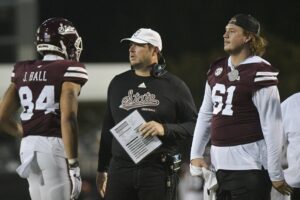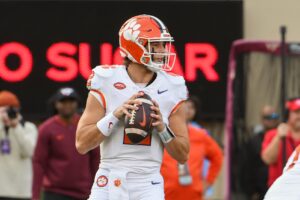NCAA president Mark Emmert addressed issue of student-athlete compensation again last week. On the hour-long conference call, he spent about ten minutes discussing name, image, and likeness (NIL) compensation. We have covered NIL compensation in depth here at Last Word on College Football. Therefore, we are taking a look at Emmert’s comments as part of our ongoing series on the topic. Long story short, during this call, Emmert made clear that the NCAA seeks Congressional input on NIL compensation. He urged the school presidents to work with their congressional representatives, believing that a national plan would be best. The alternative, he said, could be 50 states, each with their own plan.
NIL Compensation Is A “Wild West”
The current focus on NIL compensation by the NCAA kicked off when the State of California passed the Fair Pay to Play Act. The NCAA warned California schools that they could become ineligible unless California walked back its new law. But California refused to relent. Soon, other states would propose similar legislation. Most recently, Florida passed similar laws that will go into effect in 2021.
As a result of growing pressure from several states, the NCAA ultimately softened its position. This fall, the NCAA Board of Governors announced its support of NIL compensation for student-athletes. Even more recently, the NCAA provided details on the plan it supports. Instead of the NCAA retaining control of NIL compensation or the conferences or schools guiding the way, the NCAA proposed that the athletes themselves would negotiate NIL contracts.
Many, including us, predicted that allowing athletes to employ agents and negotiate NIL compensation deals directly would open a “wild west” of sorts. We knew very little about the rules and regulations that will surround the athletes, their agents, and other professionals involved in the process. We simply knew that the NCAA will allow it, and they really have very little choice at this point.
NCAA Seeks Congressional Input
From the outset, the NCAA expressed some doubt in its ability to regulate this arena. Because they announced that amateurism remained an important focus, however, the NCAA faced a tough challenge. How do we balance a potential free-for-all, and a resulting arms race to associate the best talent with the best brands, with the goal of preserving collegiate-level athletics? During last week’s call, Emmert echoed these thoughts specifically.
Nonetheless, Emmert punts on the idea of the NCAA writing the rules and regulations that will best preserve that balance. Confessing to a daunting task, Emmert beckoned “thoughtful legislative leaders” to work on solutions. He asked his university presidents to “engage with their local congress and senators to get something passed.” He said he remains concerned that “fifty different sets of rules” on NIL compensation would be “untenable.”
Emmert Attacks The Media
In his comments, Emmert also blames the media for their response to the NCAA’s October announcement. Rightly so, he says that NIL regulations are complicated. He continues, however, to say that the complex nature does not “lend to easy story telling.” He seems to miss the point of interest in the topic, though. Fans, players, professionals–they all want to know what the world of college athletics will look like in a matter of months.
Emmert, however, continues to shy away from thorough, public discourse on the nuances solutions. Instead, the NCAA seeks congressional input and attacks the media for asking hard questions. As we’ve suggested, there are many elements to a cohesive set of regulations. Who sets the rules? The NCAA? Conferences? Schools? Who should pay the players (not who ultimately will)? How can the governing bodies ensure that recruiting, transfer rules, and competitive balance are best preserved? These are questions many have asked openly. Emmert has, for the most part, refused to answer, leaving those who engage with college sports debating unknowns.
Based on his refusal to answer, some stories presumed certain facts. Many others instead openly ask difficult questions, convenient narrative be damned. Instead of inviting those discussions, however, Emmert simply says “let Congress do it” (our summary of his words), and lambastes the broader media for writing “headlines that have been just plain wrong.” He claimed he’s not “throwing rocks at anybody” and doubled down on how difficult the “story is to tell.”
The fact remains, Emmert has certainly not even tried to tell it. Indeed, he said that rolling out the rules will amount to a “large scale communications challenge.” Emmert must also admit that he has failed that challenge by failing to engage with his audience about the details.
Still More Questions Than Answers
At this point, we still have more questions than answers about how NIL compensation will work. Who will govern the details? State legislators? Congress? Athletic departments? How will conferences and divisions maintain competitive balance? How involved will agents become?
Based on Emmert’s comments, the NCAA certainly will not take the lead in answering these questions. The NCAA will, however, regulate implementation of its own rule through the process. Emmert offered the example of “boosters think[ing] [they] can have [student athletes] come and be a part of [their] car advertisements.” He quickly followed that this situation could still “create an eligibility issue for a student.” As a result, he said athletic departments must “work hard with their booster communities.” In that way, it seems as though the NCAA wants it both ways. It wants to disavow rule-making authority, but it wants to retain executive power.
Emmert shrouds his position by repeatedly confessing to the “complexity” of issues. And, as of today, we still have more questions that answers about NIL compensation. It should be an interesting push-and-pull. Emmert is right about one thing: the process will encounter plenty of challenged. It will not, however, be too hard a story to tell. In fact, the story might be as simple as this: the NCAA could easily phase itself out of anything but figurative “control.”






